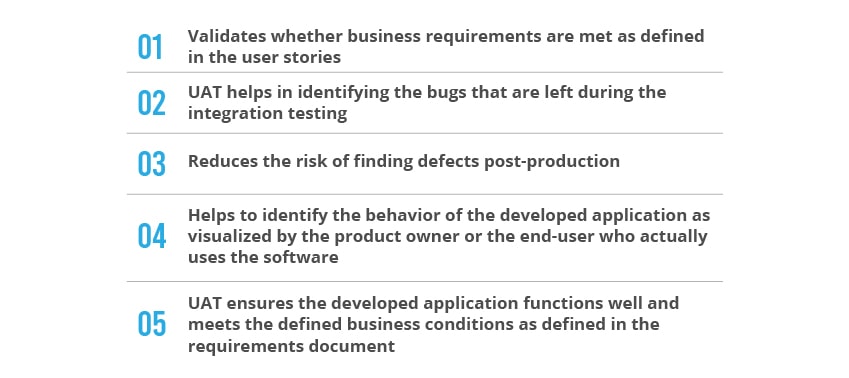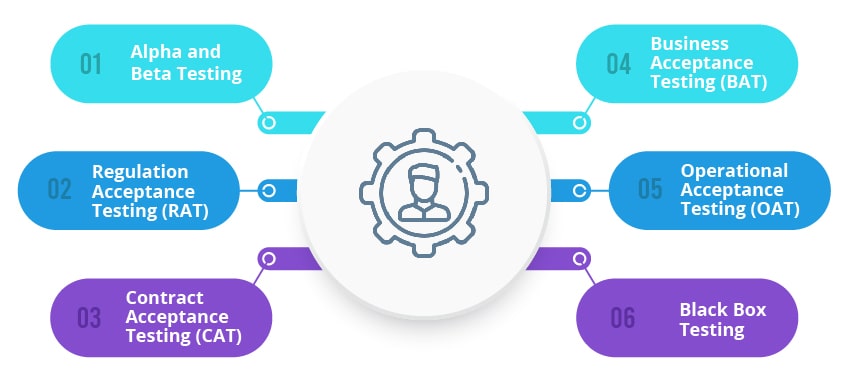
Content
- What is User Acceptance Testing (UAT)?
- Why UAT is essential for your business?
- Who Performs UAT?
- Challenges of User Acceptance Testing (UAT)
- What are the benefits of UAT for Businesses?
- Pre-requisites Businesses Must Know Before Performing UAT Testing
- Who Performs UAT?
- What are UAT best practices?
- Types of UAT Businesses Should Know
- Conclusion
In the software product development process, software testing plays an important role as it ensures and upholds the software product quality. The various phases of this software testing are Unit testing, Integration testing, System testing, Acceptance testing and interestingly, the last phase of software testing, which is named UAT or User Acceptance Testing. It has a significant role in this entire automation software testing process.
What is User Acceptance Testing (UAT)?

The last stage of the software testing process is known as UAT. This user acceptance testing process plays an important and crucial role as it validates whether all the business requirements have been fulfilled or not before releasing the actual product.
Further, UAT can also be defined as the user methodology where the developed software is tested by the business user to validate if the software is working according to the specifications defined. This type of testing is also known as beta testing, application testing or more commonly end-user testing.
The User Acceptance Testing process is taken up before planning to release the software into the market. This step ensures that the software is complete according to the functional specifications defined by the product owner, especially in e-commerce applications. It involves exposing the product or feature to real-life situations and confirming its performance from the viewpoint of end users. E-commerce User Acceptance Testing aims to verify that the system fulfils business requirements, operates as planned, and provides an excellent user experience.
It is highly essential for the product owner to take up this process else businesses suffer from significant losses due to many post-release issues.
Usually, this process is taken up as the last phase wherein intended users or rather the customer verify if the functionality as outlined in the user story or requirements documents exists. Specifically, the UAT process is taken up with a separate UAT test plan and in a separate testing environment with typically enabling production-like data set up to make the client/end-user clearly understand the developed software.
Why UAT is essential for your business?

UAT is an essential step to be taken up by the business owner / intended user / product-owner / client / stakeholder to have a first-hand understanding of software/product developed. The business user verifies and validates the software system developed before it is actually moved to the production environment.
The various stakeholders involved in the UAT process include business analyst, QA lead or Test Manager, requirements specialist (if any), and the business or product owner. Primarily, UAT ensures if the developed system can effectively be used to support the business’s day-to-day operations and works as per the user stories laid down. Typically, the product owner verifies if the solution works in full swing without any defects and confirms whether it meets their needs or not.
If any bugs are identified, then the QA team should necessarily fix them up and re-test them. Hence, it is an essential step for software product development as businesses tend to incur significant losses if post-production issues occur.
Who Performs UAT?
– Client
– End users
Challenges of User Acceptance Testing (UAT)
User Acceptance Testing (UAT) is a critical phase in the software development lifecycle where end users test the system to ensure it meets their requirement and function as intended. While UAT is important for validating the system’s usability, several challenges can be associated with it. Some of the common challenges of UAT include:
Requirement ambiguity:
One of the significant challenges is the ambiguity or incomplete understanding of user requirements. If the requirements are not well-defined or documented, it becomes challenging to perform effective UAT as users may have different interpretations or expectations.
Limited user availability:
Getting user involvement and availability during UAT can be challenging. Users are often busy with their regular responsibilities and may not have sufficient time to dedicate to testing. This can lead to delays in the UAT process or inadequate coverage of test scenarios.
Limited Scope:
It refers to the uncontrolled expansion of project requirements or changes during development. If there are frequent changes to the system functionality, it can be challenging to keep up with the changes and align UAT efforts accordingly. This can result in delays and additional efforts required for testing.
Test environment setup:
Setting up a realistic test environment that mirrors the production environment can be complex. It may involve configuring multiple systems, databases, network setups, and third-party integrations. If the test environment is not accurately replicated, it can affect the validity and reliability of UAT results.
Test data availability:
UAT requires representative and meaningful test data that simulate real-world scenarios. Acquiring or generating appropriate test data covering various use and edge cases can be challenging. Inadequate or unrealistic test data can lead to incomplete testing and may not uncover potential issues.
Communication and coordination:
Effective communication and coordination between developers, testers, and users are crucial for successful UAT. It can be challenging to ensure clear and timely communication, especially if there are multiple stakeholders involved. Miscommunication or lack of collaboration can lead to misunderstandings, delays, and inefficient testing.
Defect resolution delays:
When users identify defects or issues during UAT methodology, the resolution process becomes critical. Delays in resolving reported defects can impact the overall testing timeline and user satisfaction. Timely communication, prioritization, and coordination between the development and testing teams are essential to address issues promptly.
User expertise and training:
Users participating in UAT may have varying levels of technical expertise and may require training or guidance to effectively perform testing activities. Ensuring that users understand the testing process, have access to necessary documentation, and receive adequate training can be challenging, especially when dealing with a large user base.
Resistance to change:
UAT can sometimes highlight gaps or inconsistencies in the system, which may require changes or modifications. Resistance to change from end users or stakeholders can hinder the smooth execution of UAT and the subsequent implementation of necessary improvements.
What are the benefits of UAT for Businesses?

• Validates whether business requirements are met as defined in the user stories
• UAT helps in identifying the bugs that are left during the integration testing
• Reduces the risk of finding defects post-production
• Helps to identify the behaviour of the developed application as visualized by the product owner or the end-user who actually uses the software
• UAT ensures the developed application functions well and meets the defined business conditions as defined in the requirements document
Pre-requisites Businesses Must Know Before Performing UAT Testing
Following are the entry criteria for User Acceptance Testing:
• Check if the application code has been fully developed
• Make sure if unit testing, integration testing, system testing, and acceptance testing has all been done by the QA teams
• Check and verify if regression testing has been completed and no major defects have been identified
• Check whether all reported defects have been fixed and re-tested
• Ensure Traceability matrix should also be made available
• Ensure an effective UAT environment must be made ready
• Ensure a Sign-off mail from the system testing team is received
• Ensure to have a UAT checklist before starting the UAT process
User Acceptance Testing Phases
1. Planning Phase of UAT:
Assigning a UAT Test Manager to oversee the entire process of UAT is essentially done in this stage. Proper planning and execution strategy are outlined here. Identification of critical resources is done and preparation of a critical resource plan is done.
2. Preparation of UAT Test Data, Scenarios and Test Environment:
UAT readiness is ensured in this phase as the UAT test environment is set up, preparation of test management plan along with test data, interfaces, data, authorization along with scenario readiness is done here.
3. UAT Test Scheduling and Management:
Proper action plans with UAT priorities are done in this phase. A triage process is kept in place to prioritize the assessments of defects blocking if any. An effective mechanism to track test scenarios and test scripts based on the requirements defined is taken up.
4. UAT Testing Execution and Defect Management:
This is an important phase and proper identification of priority defects is taken up and more focus is placed on performing root cause analysis assessments. A trial run of UAT processes is done to validate execution and defects assignment and assessment is taken up for proper and quick resolution.
5. UAT, Sign-off, and Reporting:
In this final phase of UAT, accurate defect and testing status reports and defect reporting is generated from the test management system. Finally, a sign-off when all bugs have been fixed indicates the acceptance of the software. This final phase ensures and validates that the application developed meets the user requirements and is ready to be moved to production.
What are UAT best practices?
Following are the 5 UAT best practices:
1. Find Users:
User identification is the first step. Selecting a group of users (who are interested in the product) is essential for conducting UAT. These users are none other than the end-users of the product. These users can be from the company or from outside or both.
2. Document test cases:
There has to be a methodical plan for UAT testers to perform UAT productively. As these testers will be going through all the features of the product, their feedback in terms of how they want the product to function should be documented.
3. Prepare the environment:
A test environment is crucial for the success of UAT. Those users who’ve been selected to perform UAT must have the credentials and data to carry out testing effectively.
4. Remote testing counts:
As in certain scenarios, if the users are located at remote locations, it would be wise to schedule a common date and time to carry out UAT. Prior planning in terms of the technicalities involved in performing the testing activity should be clearly informed so that the users are well aware of all the implications.
5. Prioritize to detect and solve bugs:
When the test goes live, there will be issues pertaining to addressing bugs. Let the user track and properly list all the bugs that have been encountered. The concerned team responsible for fixing bugs must prioritize the bugs and then solve it accordingly in a systematic manner.
Types of UAT Businesses Should Know

Alpha and Beta Testing:

Alpha and Beta testing are the approaches in UAT that are practiced before releasing the software to the customers.
Alpha testing is practiced in the early development phase with the help of internal teams. Before releasing the software to the customers, the potential user groups conduct this testing in the development environment. The feedback received from the alpha testers helps the development teams to fix the bugs and improve the overall quality of the product.
Beta Testing takes place in the customer environment by involving a group of customers for testing. The feedback from this testing group helps in enhancing the quality of the software.
Both these testing processes are done before the actual application or software is released to production.
Regulation Acceptance Testing (RAT):

RAT, also known as Compliance Acceptance testing, is the method to validate if the developed application complies with the rules and regulations as set by the governing agencies at the governmental level. This is a very important testing practice as the application is tested for its compliance towards a set of guidelines given by the prevailing authority.
Contract Acceptance Testing (CAT):

In this type of UAT approach, the software developed is tested against certain critical criteria. These criteria and specifications have been earlier defined and mentioned while the contract is made.
Business Acceptance Testing (BAT):

BAT is a user acceptance testing type that helps to validate whether the developed software satisfies the requirements and specifications that are set by the business.
Operational Acceptance Testing (OAT):

OAT is also known as Production Acceptance Testing is one of the UAT testing types that helps in assuring whether there is a proper workflow for the software, i.e. its reliability, compatibility, stability, etc.
Black Box Testing:

In this type of UAT, the testing teams are allowed to analyze a few functionalities of the application without knowing the internal code structure. Though black box testing is categorized under functional testing, but it is a part of UAT as it uses the same principles that the user is unaware of the codebase. This testing ensures that the software meets the business requirements.
Conclusion
Businesses are in need of quality software along with faster releases today to beat the competition. Software testing is an essential component of the software product development and essentially User Acceptance testing should be taken up by the business or the product owner.
User Acceptance Testing helps in validating whether the developed software is functioning according to the requirements specified and if it meets all the user stories as defined.
Leverage next-gen independent software testing service providers that ensure the quality software is delivered with careful UAT test plans and guides businesses through to arrive at an effective User Acceptance Testing process. With this UAT approach, businesses can be rest assured of a product that effectively meets their requirements and is all ready to be moved to production.
Talk to our experts for more information on UAT testing
Discover more
Stay Updated
Subscribe for more info



